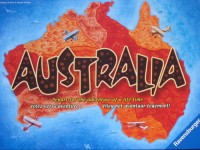
Australia
2-5
13+
75
Australia – the fifth and smallest continent at the beginning of the 1920s.
The economic crisis is yet to come – Australia is booming. Industrial modernization and development are pursued with vigour to help the economy “down under” progress. At the same time, the government is arranging for countless National Parks to be set up and are initiating numerous projects to support the natural environment. Every player leads a troop of rangers who have been assigned the task, by the government, of carrying out various conservation and industrialization projects.The most successful player wins the game.
User Reviews (1)
Add a Review for "Australia"
You must be logged in to add a review.

Overview
Australia is a board game where you travel around the map dropping off guys and picking them up. The scoring is on a track that runs around the board like ticket to ride. It plays from 2-5 players. The parts are punched car board and mini-cards. There are also plastic planes and guys. There is also a cool windmill.
Gameplay
The game a big old map of Australia that has lines and colored sections that subdivide the map into different regions. Along the region border are icons for camps. Each turn you fly around the map and place workers (rangers) on these camps. You have to play a card of the region’s color to be able to place the workers so you are somewhat limited to where you can place them. Rangers will score when you get the right number of them in a region (completing an industrialization project) or you get all the camps in a region populated (completing a conservation project). When one of those projects is completed, the person completing it gets a small bonus. Then every player who has rangers that are part of that region gets a point. The game continues with players flying around, playing cards to drop off rangers, and picking up workers to move them to another area. When all the cards are gone, the game is complete.
What is interesting
1- You have to share points with others who contribute to that total or are populating some of the camps. I get a bonus if I complete the project by placing my rangers there, but everyone who is there scores. If I am the last one to a region, place a worker, and complete one or both projects, it may score more points to the other players than for me.
2- Since these camps are on the borders of regions, if I place a worker to complete on region, it may, inadvertently, trigger the completion of a project in another region. In that case I say, “I meant to do that,” as I take my points. In our family game, we help each other out. The rules say that you don’t have to. If someone misses something, a following player can score it and take the bonus for doing so.
3- Some of the cards you play will give you money. The money can be spent to move workers or change the color of a card. Sometimes the benefit of doing one of these actions will not generate enough points to cover the cost. At the end of the game the money counts as points.
4- I have only described the basic game play. There is an advanced mechanic that adds some scoring and worker allocation decisions that I haven’t touched. This is what the windmill is for.
What I liked
– Turns are quick- just two actions.
– I love Australia.
– It takes some planning and you can be tricky with getting others to help you without them realizing it.
– Basic game rules and advanced game rules.
– It didn’t take too long – just about an hour in our initial play.
What I didn’t like
– Theme: I would like my kids to know more about Australia at the end of the game. Other than the outline of the country, there isn’t much there. It comes out in conversation and I try to identify where main cities or features would be, but otherwise, they would not get it without my teaching influence. It turns out to be an abstract game when I didn’t expect that.
– If you play with fewer players, the game dictates what colors you can choose from. They didn’t just put in 20 of each color of ranger. That way you could choose whatever color you wanted and you would only use the number of pieces needed for that player count. It turns out they only included 20 pieces in black and white, but if you play with a 3rd player, you have to use Orange since it has the 14 pieces each player gets. Black and white players discard 6 pieces each. My daughter wanted to play brown, but there wouldn’t have been enough pieces. Brown is only for a 5 player game.
Conclusion
With color choice and educational considerations as my only negatives, it is pretty clear that I liked the game. After we play it a few times we will switch over to the advance rules. That will give us a few more plays. The only variability in game play is the target for the industrialization project–how many rangers you need in each region–will change from game to game.
I don’t think I will pull it out for non-gamers–the theme is not strong enough for that.
I could see only playing this with 2-3 players. We commonly play games with 5 but, again, the theme wouldn’t keep us engaged. Engagement is needed since what the other players do is important to developing your own optimal move.